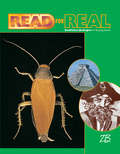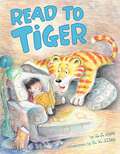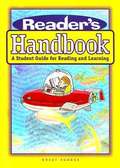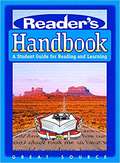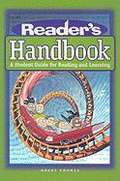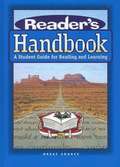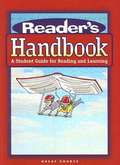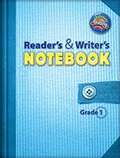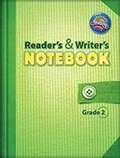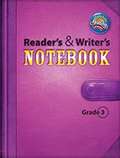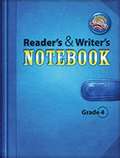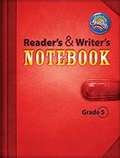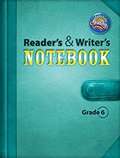- Table View
- List View
Read for Real: Nonfiction Strategies for Reading Results, Level C
by Charles E. Martin Leslie W. Crawford Margaret M. PhilbinNIMAC-sourced textbook
Read for Real: Nonfiction Strategies for Reading Results, Level D
by Charles E. Martin Leslie W. Crawford Margaret M. PhilbinNIMAC-sourced textbook
Read for Real: Nonfiction Strategies for Reading Results, Level E
by Charles E. Martin Leslie W. Crawford Margaret M. PhilbinNIMAC-sourced textbook
Read for Real: Nonfiction Strategies for Reading Results, Level F
by Charles E. Martin Leslie W. Crawford Margaret M. PhilbinNIMAC-sourced textbook
Read for Real: Nonfiction Strategies for Reading Results, Level F
by Charles E. Martin Leslie W. CrawfordNIMAC-sourced textbook
Read for Real: Nonfiction Strategies for Reading Results, Level H
by Charles E. Martin Leslie W. CrawfordNIMAC-sourced textbook
Read the Signs (Into Reading, Level D #65)
by Sheila Bailey Abby JacksonFox and his friends are walking in the woods. But only Fox knows how to read the signs. What change is coming?
Read to Tiger
by S. J. ForeIn this delightful role-reversal story, all the serious little boy wants is to settle down quietly and read his book. But that’s not so easy when there’s an imaginative tiger with an excess of energy behind the couch, wanting attention and someone to play with. Repetitive refrains and sound effects make this a perfect read-aloud, and the sweet and cozy ending will delight the heart of any book-lover.
Reader in American History (Third Edition)
by Randolph B. CampbellThis collection of essays is intended to serve as supplementary reading in survey courses on the history of the United States to 1865.
Reader's Companion for Prentice Hall Timeless Voices, Timeless Themes (Bronze Level)
by Pearson Prentice HallThe Reader's Companion is a special kind of literature book, one that will guide you to become an active reader. Each unit contains two selections with notes and suggestions that will help you become actively involved in what you read and help you practice the sets of skills that effective readers use.
Reader's Handbook, A Student Guide for Reading and Learning
by Laura Robb Phil Laleike Mike Mcconnell Margaret Ann Richek Vicki Spandel- In-depth understanding of the Before, During, and After reading process- Essential skills and strategies for a variety of materials and genres- Key comprehension tools, including notetaking, outlining, cause-effect diagrams, and double-entry journals- A resource for content area reading, supplemental reading activities, tutorials, and homework support
Reader's Handbook: A Student Guide For Reading And Learning (Great Source Reader's Handbooks Ser.)
by Jim Burke Ron Klemp Wendell Schwartz Mike McConnell Phil LaLeikeNIMAC-sourced textbook
Reader's Handbook: A Student Guide for Reading and Learning
by April Nauman Donna Ogle Laura Robb Phil Laleike Mike Mcconnell- In-depth understanding of the Before, During, and After reading process- Essential skills and strategies for a variety of materials and genres- Key comprehension tools, including notetaking, outlining, cause-effect diagrams, and double-entry journals- A resource for content area reading, supplemental reading activities, tutorials, and homework support
Reader's Handbook: A Student Guide for Reading and Learning
by Jim Burke Ron Klemp Wendell SchwartzLike all good guidebooks, this one has a few simple but important goals. (1) It will show you how to become a better reader. (2) It will introduce tools, tips, and strategies to help you read better and be more successful in school. (3) It will teach you how to monitor your reading. (4) It will improve your ability to write and talk about reading. (5) It will provide you with a quick reference guide. (6) It will introduce various kinds of readings.
Reader's Handbook: A Student Guide for Reading and Learning
by Laura Robb Phil Laleike Mike Mcconnell Ron Klemp Wendell SchwartzNIMAC-sourced textbook
Reader's and Writer's Notebook [Grade 4]
by Pearson EducationNIMAC-sourced textbook<P><P> <i>Advisory: Bookshare has learned that this book offers only partial accessibility. We have kept it in the collection because it is useful for some of our members. To explore further access options with us, please contact us through the Book Quality link on the right sidebar. Benetech is actively working on projects to improve accessibility issues such as these. </i>
Reader, Grade 4, Unit 1: Personal Narratives, Childhood Memories
by Core Knowledge FoundationNIMAC-sourced textbook

